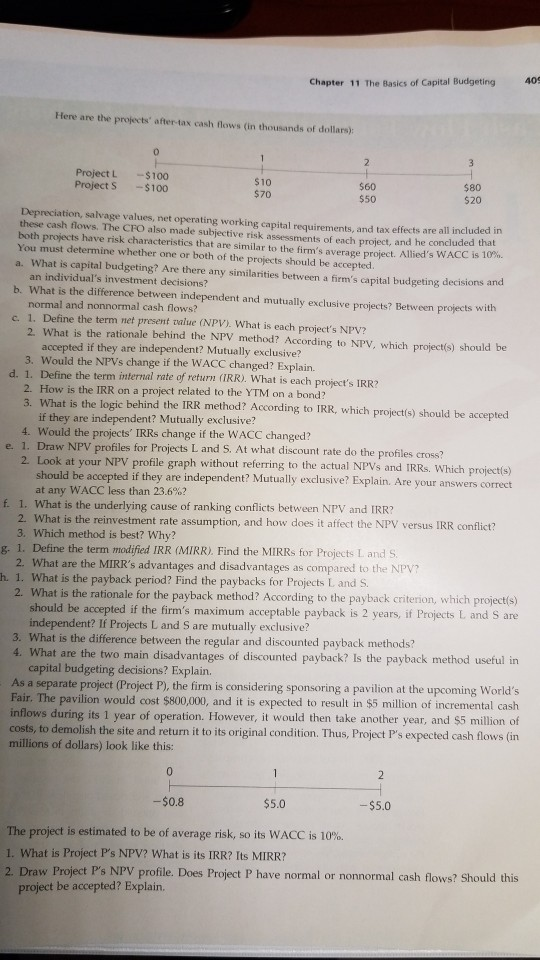Answered step by step
Verified Expert Solution
Question
1 Approved Answer
can anyone help. Please dont copy and paste someone's else answers. Thank you. ALLIED COMPONENTS COMPANY 11-24 BASICS OF CAPITAL BUDGETING You recently went to


can anyone help. Please dont copy and paste someone's else answers. Thank you.
ALLIED COMPONENTS COMPANY 11-24 BASICS OF CAPITAL BUDGETING You recently went to work for Allied Components Company. a supplier of auto repair parts used in the after-market with products from Daimler AG, Ford, Toy and other automakers. Your boss, the chief financial officer (CFO), has just handed you the estim cash flows for two proposed projects. Project L involves adding a new item to the firm's ign system line; it would take some time to build up the m would increase over time. Project S involves an add-on to an existing line, and its cash flows w ota, ated arket for this product, so the cash inflows oul decrease over time. Both projects have 3-year lives because Allied is planning to introduce entirely new models after 3 years. Chapter 11 The Basics of Capital Budgeting 40s Here are the projects' after-tax cash flows (in thousands of dollars 0 Project L $100 Project S $100 $80 $20 $60 $50 $70 Depreciation, salvage values, net operating working capital requirements, and tax effects are all included in these cash flows. The CFO also made subjective risk assessments of each project, and he concludeda both projects have risk characteristics that are similar to the firm's average project. Allied's W You must determine whether one or both of the projects should be accepted a. What is capital budgeting? Are there any similarities between a firm's capital budgeting decisions and b. What is the difference between independent and mutually exclusive projects? Between projects with normal and nonnormal cash flows? c. 1. Define the term net present talue (NPV). What is each project's NPV? 2. What is the rationale behind the NPV method? According to NPV, which project(s) should be accepted if they are independent? Mutually exclusive? 3. Would the NPVs change if the WACC changed? Explain. d. 1. Define the term internal rate of return (IRR). What is each project's IRR? 2. How is the IRR on a project related to the YTM on a bond? 3. What is the logic behind the IRR method? According to IRR, which project(s) should be accepted if they are independent? Mutually exclusive? 4. Would the projects' IRRs change if the WACC changed? e. 1. Draw NPV profiles for Projects L and S. At what discount rate do the profiles cross 2. Look at your NPV profile graph without referring to the actual NPVs and IRRs. Whichp independent? Mutually exclusive? Explain. Are your answers correct should be accepted if they are at any WACC less than 23.6%? f. 1. What is the underlying cause of ranking conflicts between NPV and IRR? g. 1. Define the term modified IRR (MIRR). Find the MIRRs for Projects L and S h. 1. What is the payback period? Find the paybacks for Projects L and S at is the reinvestment rate assumption, and how does it affect the NPV versus IRR conflict? 3. Which method is best? Why? 2. What are the MIRR's advantages and disadvantages as compared to the NPV? t is the rationale for the payback method? According to the payback criterion, which projects) should be accepted if the firm's maximum acceptable payback is 2 years, if Projects L and S are independent? If Projects L and S are mutually exclusive? 3. What is the difference between the regular and discounted payback methods? 4. What are the two main disadvantages of discounted payback? Is the payback method useful in capital budgeting decisions? Explain. As a separate project (Project P), the firm is considering sponsoring a pavilion at the upcoming Fair. The pavilion would cost $800,000, and it is expected to result in $5 million of incremental cash inflows during its 1 year of operation. However, it would then take another year, and $5 million of costs, to demolish the site and return it to its original condition. Thus, Project P's expected cash flows (in millions of dollars) look like this: -$0.8 $5.0 -$5.0 The project is estimated to be of average risk, so its WACC is 10%. 1. What is Project P's NPV? What is its IRR? Its MIRR? 2. Draw Project P's NPV profile. Does Project P have normal or nonnormal cash flows? Should this project be accepted? Explain. ALLIED COMPONENTS COMPANY 11-24 BASICS OF CAPITAL BUDGETING You recently went to work for Allied Components Company. a supplier of auto repair parts used in the after-market with products from Daimler AG, Ford, Toy and other automakers. Your boss, the chief financial officer (CFO), has just handed you the estim cash flows for two proposed projects. Project L involves adding a new item to the firm's ign system line; it would take some time to build up the m would increase over time. Project S involves an add-on to an existing line, and its cash flows w ota, ated arket for this product, so the cash inflows oul decrease over time. Both projects have 3-year lives because Allied is planning to introduce entirely new models after 3 years. Chapter 11 The Basics of Capital Budgeting 40s Here are the projects' after-tax cash flows (in thousands of dollars 0 Project L $100 Project S $100 $80 $20 $60 $50 $70 Depreciation, salvage values, net operating working capital requirements, and tax effects are all included in these cash flows. The CFO also made subjective risk assessments of each project, and he concludeda both projects have risk characteristics that are similar to the firm's average project. Allied's W You must determine whether one or both of the projects should be accepted a. What is capital budgeting? Are there any similarities between a firm's capital budgeting decisions and b. What is the difference between independent and mutually exclusive projects? Between projects with normal and nonnormal cash flows? c. 1. Define the term net present talue (NPV). What is each project's NPV? 2. What is the rationale behind the NPV method? According to NPV, which project(s) should be accepted if they are independent? Mutually exclusive? 3. Would the NPVs change if the WACC changed? Explain. d. 1. Define the term internal rate of return (IRR). What is each project's IRR? 2. How is the IRR on a project related to the YTM on a bond? 3. What is the logic behind the IRR method? According to IRR, which project(s) should be accepted if they are independent? Mutually exclusive? 4. Would the projects' IRRs change if the WACC changed? e. 1. Draw NPV profiles for Projects L and S. At what discount rate do the profiles cross 2. Look at your NPV profile graph without referring to the actual NPVs and IRRs. Whichp independent? Mutually exclusive? Explain. Are your answers correct should be accepted if they are at any WACC less than 23.6%? f. 1. What is the underlying cause of ranking conflicts between NPV and IRR? g. 1. Define the term modified IRR (MIRR). Find the MIRRs for Projects L and S h. 1. What is the payback period? Find the paybacks for Projects L and S at is the reinvestment rate assumption, and how does it affect the NPV versus IRR conflict? 3. Which method is best? Why? 2. What are the MIRR's advantages and disadvantages as compared to the NPV? t is the rationale for the payback method? According to the payback criterion, which projects) should be accepted if the firm's maximum acceptable payback is 2 years, if Projects L and S are independent? If Projects L and S are mutually exclusive? 3. What is the difference between the regular and discounted payback methods? 4. What are the two main disadvantages of discounted payback? Is the payback method useful in capital budgeting decisions? Explain. As a separate project (Project P), the firm is considering sponsoring a pavilion at the upcoming Fair. The pavilion would cost $800,000, and it is expected to result in $5 million of incremental cash inflows during its 1 year of operation. However, it would then take another year, and $5 million of costs, to demolish the site and return it to its original condition. Thus, Project P's expected cash flows (in millions of dollars) look like this: -$0.8 $5.0 -$5.0 The project is estimated to be of average risk, so its WACC is 10%. 1. What is Project P's NPV? What is its IRR? Its MIRR? 2. Draw Project P's NPV profile. Does Project P have normal or nonnormal cash flows? Should this project be accepted? ExplainStep by Step Solution
There are 3 Steps involved in it
Step: 1

Get Instant Access to Expert-Tailored Solutions
See step-by-step solutions with expert insights and AI powered tools for academic success
Step: 2

Step: 3

Ace Your Homework with AI
Get the answers you need in no time with our AI-driven, step-by-step assistance
Get Started


